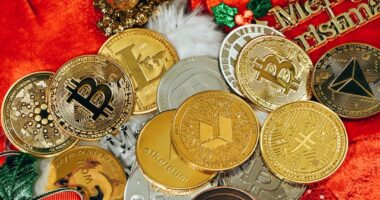Non-fungible tokens (NFTs) are digital assets that represent ownership or authenticity of unique items or content, utilizing blockchain technology for verification. Unlike fungible cryptocurrencies such as Bitcoin or Ethereum, NFTs are non-interchangeable due to their unique nature. NFTs can represent various digital and physical assets, including artwork, music, videos, virtual real estate, and social media content.
When creators produce an NFT, they generate a digital ownership certificate for their work, which can be traded on online marketplaces. The ownership and provenance of NFTs are recorded on a blockchain, a decentralized and transparent digital ledger that ensures secure and unalterable information storage. This technology has transformed the buying and selling of digital assets, providing new monetization opportunities for creators and investment options for collectors.
NFTs have enabled artists to sell their digital works directly to consumers, bypassing traditional intermediaries and potentially earning higher profits. The rise of NFTs has sparked a digital revolution in the art world and beyond. As this technology continues to evolve, it is crucial for creators, collectors, and investors to understand the mechanics and potential benefits of NFTs in the rapidly changing digital landscape.
Key Takeaways
- NFTs are unique digital assets that represent ownership of a specific item or piece of content on the blockchain.
- Artists can create NFTs by minting them on a blockchain platform, which involves uploading the digital file, setting the parameters, and paying a gas fee.
- When choosing an NFT marketplace, artists should consider factors such as fees, user base, and the platform’s reputation for security and authenticity.
- Pricing NFTs can be challenging, but artists and collectors can use factors such as scarcity, demand, and the artist’s reputation to determine a fair price.
- Marketing NFTs involves leveraging social media, collaborating with influencers, and creating a compelling narrative around the artwork to attract potential buyers.
Creating an NFT: Step-by-Step Guide for Artists
Choosing the Right Platform
Creating an NFT can be an exciting opportunity for artists to monetize their work and reach a new audience. The first step is to choose the right platform to create and sell NFTs. There are several online marketplaces to consider, such as OpenSea, Rarible, and Foundation. Each platform has its own requirements and fees, so it’s essential to research and choose the one that best fits your needs.
Creating Your Digital Artwork
Once you’ve chosen a platform, you’ll need to create the digital artwork that you want to turn into an NFT. This could be a digital painting, illustration, animation, or any other type of digital content.
Minting and Setting Up Your NFT
Minting an NFT involves uploading your digital artwork to the chosen marketplace and creating a unique token for it on the blockchain. This process typically involves paying a gas fee, which can vary depending on network congestion and the chosen platform. When minting your NFT, you’ll have the opportunity to set the terms of the sale, including the price, royalties for future sales, and any additional conditions you want to include.
Listing and Selling Your NFT
Once your NFT is minted, it will be listed for sale on the marketplace, where collectors can browse and purchase it using cryptocurrency. By following these steps, artists can take advantage of the growing NFT market and reach a new audience of collectors.
Choosing the Right NFT Marketplace: A Comparison

With the growing popularity of NFTs, there are now numerous online marketplaces where artists can create and sell their digital assets. Each marketplace has its own features, fees, and community, so it’s important for artists to choose the right platform for their needs. Here’s a comparison of some popular NFT marketplaces: 1.
OpenSea: OpenSea is one of the largest and most well-known NFT marketplaces, offering a wide range of digital assets including art, domain names, virtual worlds, and more. It allows users to create and sell their own NFTs without any upfront fees, but charges a 2.5% commission on sales. 2.
Rarible: Rarible is a decentralized NFT marketplace that allows artists to create and sell their digital assets with minimal fees. It also has its own governance token (RARI) that allows users to participate in platform decisions. 3.
Foundation: Foundation is an invite-only NFT marketplace that focuses on supporting emerging artists and creators. It has a curated selection of digital art and offers a more exclusive environment for buying and selling NFTs. 4.
SuperRare: SuperRare is a high-end NFT marketplace that focuses on rare digital art from top artists. It has a rigorous curation process and higher entry barriers for artists looking to sell their work. In conclusion, there are several NFT marketplaces available for artists to choose from, each with its own features, fees, and community.
By comparing these platforms and considering their individual strengths and weaknesses, artists can find the right marketplace to create and sell their NFTs.
Pricing Your NFT: Tips for Artists and Collectors
Pricing NFTs can be a complex process that requires careful consideration of various factors such as the artist’s reputation, the rarity of the artwork, current market trends, and collector demand. Here are some tips for artists and collectors when pricing NFTs: For Artists:
1. Consider your reputation: Established artists with a strong following may be able to command higher prices for their NFTs due to their reputation and demand for their work.
2.
Evaluate rarity: The rarity of the artwork can also impact its price, with one-of-a-kind pieces often fetching higher prices than more common works.
3. Research market trends: Keeping an eye on current market trends can help artists gauge collector demand and set competitive prices for their NFTs.
4. Factor in royalties: Artists can also earn royalties on secondary sales of their NFTs, so it’s important to consider this when setting the initial price.
For Collectors:
1. Research the artist: Before purchasing an NFT, collectors should research the artist’s reputation and previous sales to gauge the value of the artwork.
2. Evaluate rarity: Collectors should consider the rarity of the artwork and its potential for appreciation in value over time.
3.
Set a budget: Setting a budget can help collectors avoid overspending on NFTs and make more informed purchasing decisions.
4. Consider long-term value: Collectors should consider the long-term value of an NFT when making a purchase, taking into account factors such as the artist’s reputation and potential for future appreciation. In conclusion, pricing NFTs requires careful consideration of various factors such as the artist’s reputation, rarity of the artwork, current market trends, and collector demand.
By following these tips, artists and collectors can set competitive prices for their NFTs and make more informed purchasing decisions.
Marketing Your NFT: Strategies for Success
Marketing plays a crucial role in the success of selling NFTs, as it helps artists reach a wider audience of potential collectors and generate interest in their digital assets. Here are some strategies for marketing NFTs: 1. Build a strong online presence: Artists should leverage social media platforms, personal websites, and online art communities to showcase their work and build a strong online presence that attracts potential collectors.
2. Tell your story: Sharing the inspiration behind your artwork or the creative process involved in its creation can help connect with collectors on a personal level and generate interest in your NFTs. 3.
Collaborate with influencers: Partnering with influencers or other artists in the NFT space can help expand your reach and introduce your work to new audiences. 4. Engage with your community: Engaging with your audience through live streams, Q&A sessions, or behind-the-scenes content can help build a loyal fan base that supports your NFT sales.
5. Offer incentives: Providing incentives such as limited edition prints or exclusive access to future works can incentivize collectors to purchase your NFTs. In conclusion, marketing plays a crucial role in the success of selling NFTs by helping artists reach a wider audience of potential collectors and generate interest in their digital assets.
By implementing these strategies, artists can effectively market their NFTs and increase their chances of successful sales.
Selling Your NFT: Best Practices for Artists and Collectors

Timing and Promotion Strategies for Artists
When selling an NFT, timing is crucial. Consider releasing your NFT to coincide with relevant events or milestones that can generate buzz around your artwork. Additionally, promote your NFT through social media platforms, email newsletters, and other marketing channels to generate interest from potential collectors. Engaging with your audience through live streams or Q&A sessions can also help build excitement around your NFT release.
Pricing Strategies and Legal Considerations for Artists
Experiment with different pricing strategies, such as auctions or fixed prices, to find the best approach for selling your NFT. Furthermore, consider legal considerations, such as copyright issues or resale rights, to ensure a smooth transaction.
Best Practices for Collectors
Before purchasing an NFT, research the artist’s reputation, previous sales, and potential for future appreciation to make an informed decision. Understand legal considerations, such as copyright issues or resale rights, and ensure that your NFT is stored securely in a digital wallet to prevent loss or theft. By following these best practices, artists can increase their chances of successful sales, and collectors can make more informed purchasing decisions.
Navigating Legal and Copyright Issues in NFT Sales
The rise of NFTs has brought about new legal considerations related to copyright ownership, intellectual property rights, resale rights, and contractual agreements between artists and collectors. Here are some key legal considerations when navigating NFT sales: 1. Copyright ownership: Artists should ensure that they have clear ownership of the copyright for the digital artwork being sold as an NFT to avoid potential legal disputes in the future.
2.
Intellectual property rights: Artists should be aware of any intellectual property rights associated with their work when creating and selling an NFT to avoid infringing on others’ rights.
3. Resale rights: Some jurisdictions have laws that entitle artists to receive royalties from secondary sales of their artwork as an NFT; it’s important for both artists and collectors to understand these rights when buying or selling NFTs.
4. Contractual agreements: Artists should consider including contractual agreements in their NFT sales that outline terms such as royalties on secondary sales or limitations on reproduction rights.
In conclusion, navigating legal and copyright issues in NFT sales requires careful consideration of copyright ownership, intellectual property rights, resale rights, contractual agreements between artists and collectors. By being aware of these legal considerations when creating or purchasing an NFT, artists and collectors can protect themselves from potential legal disputes in the future.
If you’re interested in learning more about the latest news and updates in the world of NFTs, be sure to check out the latest articles on ETH News. Whether you’re an artist looking to sell your own NFTs or a collector interested in purchasing them, ETH News provides valuable insights and information to help you navigate the rapidly evolving NFT market. Their article “Hello World” offers a great introduction to the world of NFTs and is a must-read for anyone looking to get started in this exciting new space.
FAQs
What is an NFT?
An NFT, or non-fungible token, is a digital asset that represents ownership or proof of authenticity of a unique item or piece of content, such as artwork, music, videos, or collectibles, using blockchain technology.
How do you sell an NFT?
To sell an NFT, artists and collectors can use online platforms called NFT marketplaces, where they can create and list their digital assets for sale. The process typically involves creating a digital wallet, minting the NFT, setting a price, and listing it for sale.
What are NFT marketplaces?
NFT marketplaces are online platforms where artists and collectors can buy, sell, and trade NFTs. Some popular NFT marketplaces include OpenSea, Rarible, and Foundation.
What is the process of minting an NFT?
Minting an NFT involves creating a unique digital token on a blockchain network, such as Ethereum, that represents ownership of a specific digital asset. This process typically requires using a digital wallet and paying a fee for the transaction.
How do artists and collectors receive payment for NFT sales?
When an NFT is sold, the payment is typically made in cryptocurrency, such as Ethereum or other tokens supported by the NFT marketplace. The funds are then transferred to the seller’s digital wallet.
What are the potential benefits of selling NFTs for artists and collectors?
Selling NFTs can provide artists and collectors with a new way to monetize their digital creations, reach a global audience, and retain ownership and control over their work. Additionally, NFTs can enable creators to earn royalties on secondary sales of their digital assets.





